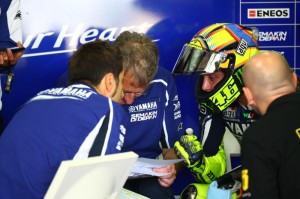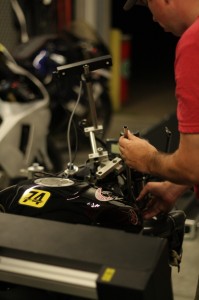You’ve bought the most expensive suspension, worked with a number of suspension tuners, talked to the most talented riders, and even turned every adjuster you can get your hands on. But for some reason you can not get any faster on your bike. I’ll give you one word that will fix all your issues, geometry. And it is what the pro road racers live by!
While at a few AMA rounds with Lenny Albin this year, Lenny and I worked on a wide variety of rider issues. Nine times out of ten these issues consisted of chassis balance and geometry. By considering geometry numbers and getting rider feedback we were able correct any issue. And at the pro level, most, if not all teams work in this fashion to keep their riders at the front of the pack.

So what is geometry and why should you care? Geometry consists of a number of measurements throughout the bike that tell us how the bike is going to handle. Do you have problems turning in? Do you get wheel spin driving out of turns? Do you get chatter mid-corner? Does the bike feel like the front wants to wash out on entry? All of these symptoms are due to improper geometry setup. Once a bike is properly set up the bike starts working with you, instead of against you!
You’re probably asking yourself what are these magic numbers and how to I achieve them, right? The truth is you probably already know what they are, or at least have heard of them. They consist of rake, trail, wheel base, and swing-arm angle. So how do they work? Rake is measured in degrees and is the angle of the frame neck. Rake gives the bike it’s “flickability”, allowing you to changed direction or throw the bike into a corner. Trail is a measurement along the ground relative to the front axle and rake angle. Trail gives you grip or stability. When a bike wants to wash out or drives wide on entry, it’s due to too much or too little trail. Swing-arm angle is measured again, in degrees, and is taken from the swing-arm pivot and the rear axle. This helps to determine your grip driving out of corners. And finally we have wheelbase. Wheelbase plays into all three other measurements to help get your numbers you want to achieve.

With the basics out of the way the next question is how do you get these numbers? Most manufactures will give you the overall numbers. But one thing to remember is changing tires, gearing, moving axles, and changing fork/shock height will immediately change these numbers. You can try and measure manually, but this is extremely tedious and hard to replicate. Many suspension shops and race teams will use software like Suspact, Motorcycle Setup Analysis Software, and MotoSPEC. Each piece of software uses known dimensions to compare your bike to. While this may help, you can never get a complete accurate measurement. But with that being said software like MotoSPEC is GREAT to help figure dynamic numbers. And last you have chassis/geometry measuring machines like Computrack and Scheibner. Using a measuring machine allows a complete measurement and analysis of the bike, taking out any guesswork.
Also make sure to click here to see how we can help set up your geometry.
The beauty about geometry is it doesn’t care whether you have $10,000 Ohlins or OEM Showa suspension. Whether you’re a novice brand new to the track or a seasoned racer going after a championship. So the next time you’re having handling problems, before you reach for the screwdriver to change damping, make sure to consider your geometry.
